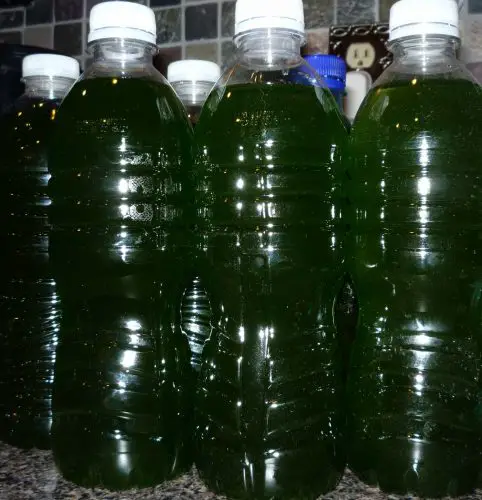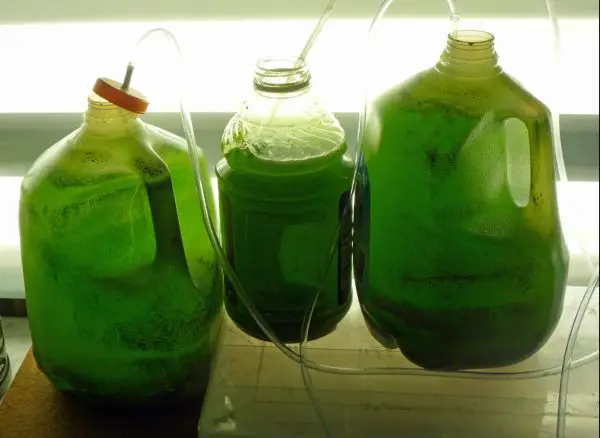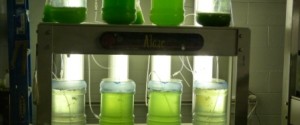The subject of dosing phytoplankton in a marine aquarium is a popular debate in online forums. Generally, there are advocates in favor of dosing phytoplankton and those who believe the potential risks outweigh the benefits. This article covers several topics related to dosing phytoplankton in a marine aquarium, including:
- What are phytoplankton
- Arguments for and against dosing phytoplankton
- Do corals need phytoplankton in their diets?
- Two common approaches to dosing phytoplankton in a marine aquarium
- How to dose phytoplankton
- Dosing equipment
- How to store phytoplankton
- How to grow a phytoplankton culture at home

What is phytoplankton?
Phytoplankton (also called microalgae) are small photosynthetic organisms (similar to single-celled plants) that make up the bottom of the food chain. Drifting along in the ocean, phytoplankton turns light energy from the sun and carbon dioxide into the life-sustaining sugar called glucose. In fact, the name phytoplankton is based on Greek words for “plant drifters” (according to Wikipedia), to further characterize their floating plant-like life. Like land plants, phytoplankton converts light into sugar by a process called photosynthesis.
Phytoplankton are considered to be primary producers, in the food web, which basically means that they make their own food and lots of other things depend on it as their food. The NASA website has a pretty cool primer on phytoplankton if you want to learn more. Those pages are beyond the scope of this article here.
As primary producers, many marine filter-feeding invertebrates one link up in the food chain depend on phytoplankton as a primary or secondary food source. Many phytoplankton species are a nutritious source of the Omega 3 Highly Unsaturated Fatty Acids (HUFAs) EPA and DHA (eicosapentaenoic acid and docosahexaenoic acid) which are even thought to be beneficial in human diets. These Essential Fatty Acids are one of the beneficial components of Fish Oil that is commonly consumed as a nutritional supplement or pharmaceutical prescription. If you were to trace these HUFAs down the food chain from the Fish Oil, you would find phytoplankton there as the first link in that food chain.
You will see EPA and DHA prominently displayed on baby formula containers because those nutrients are thought to help brain development in infants, and fish oils are also taken as a supplement (or prescription) for people with high triglycerides (a cardiovascular problem). While not directly applicable to the marine aquarium hobby, I include those other reference points just to point out how important phytoplankton are to sustaining life all over the world.

Arguments for and against dosing phytoplankton in a marine aquarium
For Dosing Phytoplankton
On a natural coral reef, phytoplankton are an abundant food source for many clams (and other bivalves), soft corals, sponges, and zooplankton-like copepods. In the home marine aquarium, however, phytoplankton are generally not present. Those aquarists in favor of dosing phytoplankton, therefore, are attempting to provide this natural food source to the invertebrates in their tanks.
The argument for dosing phytoplankton is generally based on two principles:
- Phytoplankton are natural food for many filter-feeding invertebrates
- Dosing phytoplankton provides a nutritional boost for the clams, filter-feeding corals and other beneficial invertebrates like copepods in their marine aquarium
Against Dosing Phytoplankton
Of course, there are also aquarists who are opposed to dosing phytoplankton in a marine aquarium.
The argument against dosing phytoplankton is usually based on two principles:
- Many of the coral and invertebrate species in a marine aquarium are not thought to directly feed on phytoplankton, which could make dosing phytoplankton a waste of time and money
- Dosing phytoplankton in a marine aquarium also adds phosphates, nitrates, silicates and can actually cause water parameters to deteriorate in an otherwise healthy marine aquarium.
Do corals need phytoplankton in their diets?
Whether or not corals need phytoplankton in their diet has been a topic of debate for some time. Many soft coral species are thought to depend on phytoplankton for a significant percentage of their nutrition. An article from Coralscience.org suggests that many of the soft coral species that feed on phytoplankton possess pinnula, tiny feather-like extensions on their polyps, like the polyps on Xenia.
The jury appears to still be out on stony corals, by comparison. According to an article by Eric Borneman on Reefkeeping.com, multiple research studies on stony corals have produced conflicting results. One study reported that Acropora, Montipora, Porites, and Tubastraea stony corals ingest (or at least clear) phytoplankton from the water—while another suggested that only Astrangia and Porites ingest phytoplankton (Source: Reefkeeping.com).
While not every species of coral will feed on phytoplankton, it does appear to be a beneficial food source for many species. Phytoplankton are also a major food source for tiny invertebrates like copepods—so dosing phytoplankton may provide a secondary benefit to predatory corals and fish in your aquarium. The decision about whether or not to dose phytoplankton in your aquarium, therefore, is going to be a personal decision about the relative benefits compared with the cost. If you choose to dose phytoplankton in your marine aquarium, there are two common ways of doing so.
Two Common Approaches to Dosing Phytoplankton in a Marine Aquarium
Direct Dosing
Direct dosing phytoplankton is the technique used when you aim a tiny burst of phyto directly towards the extended polyps of the targeted coral or clam. To dose phytoplankton directly, you need an eyedropper, turkey baster, or pipette to extract a small amount of phyto from the bottle. For more precise direct dosing of the phytoplankton, you can pick up a specialty feeder for about $15 on Amazon (affiliate link).
The next steps are fairly straightforward:
- Use your eye-dropper or pipette to suck up some of the phyto
- Slowly move the tip of the dropper next to the target coral or clam
- Gently squeeze the bulb at the top of the eyedropper to carefully release the phytoplankton contents inside the dropper
- Repeat this step for every coral you intend to feed
The advantage of direct dosing phytoplankton is that since you are target-feeding your coral, you only use a small amount of phyto, which keeps costs and the risk of deteriorating the water quality low. The disadvantage of direct dosing is that it is time and labor-intensive (relative to indirect dosing) and the benefits to copepods and the other tiny invertebrates in your live rock and sand are minimal.
Indirect Dosing
Indirect dosing phytoplankton, by comparison, is a technique used when you add the phyto to the water column without targeting any specific coral or invertebrate. While the overall volume of phytoplankton dosed may still be small (when compared with the tank volume), the dose administered for the indirect method should be much larger than when direct dosing—because the concentration of phytoplankton will be diluted by the large volume of your aquarium.
The method you choose for dosing phytoplankton in your marine aquarium is going to be a personal decision you have to make—based on your own style and beliefs about the benefits of the phytoplankton to the inhabitants in your tank, as well as the level of involvement you want to have in the meticulous feeding of these organisms. If you are unsure which method will be right for you, consider alternating between the indirect and direct methods.
Using a protein skimmer when dosing phytoplankton
Another important thing to remember is that your protein skimmer if left on while you dose phytoplankton for your corals, will skim the phytoplankton out of your aquarium. So it is best to turn off your protein skimmer before you dose phytoplankton into your marine aquarium. Just remember to turn your skimmer back on when you are finished, or you’ll have bigger problems than you had bargained for.
How to dose phytoplankton
Manual dosing phytoplankton
If you do not grow your own phytoplankton or purchase commercial products infrequently, then manual dosing will likely be your preferred means of adding the phyto to your marine aquarium. If you plan to dose indirectly, the task could be as simple as measuring out a few capfuls of the stuff and pouring it indiscriminately into your tank. If, on the other hand, you want to feed specific corals or clams, then you will need an eye-dropper, turkey baster, pipette or another tool to help you disperse the phyto right where you want it.
Advantages of manual dosing
The advantages of manual dosing are:
- As long as you have hands, you can dose phytoplankton
- No added cost and technical complexity from dosing equipment
- You also never have to worry about pump failure.
Disadvantages of manual dosing
There are a few disadvantages of manual dosing:
- Unless you schedule a routine, you may find it difficult to dose phytoplankton with any consistency
- The task of manual dosing may become a chore
- Opportunity and risk for human error are very high–you might…
- Leave the phytoplankton out overnight, causing it to spoil
- Spill the bottle
- Accidentally overdose your tank
There is no guarantee you will do any of that–but the more often you manually dose, the more opportunities you have for something to go wrong.
Automated dosing phytoplankton
If you are a little more tech-savvy, have a slightly bigger budget, or value consistency for your saltwater aquarium, then automated dosing of your phytoplankton may be the best option for you. The basic principle here is to set it and forget it. You set up a reservoir, which is just a fancy word for a container with the phytoplankton you want to dose, connect some tubing and a pump and you program the pump to slowly, steadily drip phytoplankton into your aquarium until the reservoir is emptied. The only work involved is with setting up the drip, refilling the reservoir, and performing maintenance, if needed, on the pump.
Advantages of automated dosing phytoplankton
The advantages of automated dosing phytoplankton are:
- Maintaining consistent levels of phytoplankton in your system is likely better for your aquarium than the ups and downs associated with manual dosing
- Once you setup your system, the work involved is minimal
- You eliminate a significant opportunity for human error by automating your system
Disadvantages of automated dosing phytoplankton
The disadvantages of automated dosing phytoplankton are:
- Setting up an automated system adds complexity and cost to your aquarium
- Pumps and hoses may fail eventually, causing a mess when it does happen
Dosing equipment
For manual dosing
-A bottle of Kent Marine PhytoPlex, or equivalent (that is an affiliate link to the product where you could purchase it, if you choose, from Amazon.com).
-An eyedropper or turkey baster
For automated dosing
-Reef dosing pump–you have the option to select a single dosing pump or a multi-pump unit. These can range from about $100 to $500 depending on the number of pumps and features.
-Tubing
-Bottle or reservoir
As you can see from the equipment list–neither option is over-the-top complicated. I have seen mentions of connecting single-unit pumps with electric on/off timers to program an analog pump or put in a fail-safe–but that is beyond the scope of what’s intended here.
How to store phytoplankton
Phytoplankton cultures you intend to feed to your marine aquarium are generally best kept in the refrigerator. While the cultures themselves were probably grown at an aquaculture facility at room temperature, the fact is that a thriving phytoplankton culture typically grows at a less concentrated level than the culture in the bottle you bought at your local fish store. If that bottle was to warm up to room temperature, the phyto would most likely die and foul up the water in the bottle. If your phytoplankton culture smells spoiled, it probably is. Dispose of it and start over with a fresh bottle.
For what it’s worth, this is the single biggest hassle I have encountered with dosing phytoplankton. The chore of placing the bottle back in the refrigerator when finished is something easy to forget and regret.
Another consideration when storing phytoplankton in your refrigerator is that the phyto will settle to the bottom of the bottle. If the tiny cells of phyto that are stuck at the bottom of the bottle remain stuck there too long, they will die. When they die they will also foul the water inside the bottle and can cause the contents of the whole bottle to spoil. Make sure you shake up your phytoplankton culture every few days to keep the phyto suspended in the water column, rather than layered on the bottom of the bottle.
DT’s Phytoplankton brand is one of the more commonly available brands of phyto at your local fish store.
While they clearly have an incentive for promoting the use of phytoplankton in marine aquariums, they do have some interesting information on their website. One section they call Phytoplankton feeding trials, which shows some interesting data supporting a boost in growth seen when phytoplankton were added.
Growing a phytoplankton culture at home

Perhaps the best place to get fresh phytoplankton to dose in your marine aquarium is to grow your own phytoplankton at home. It’s easy to do, inexpensive, and only requires equipment you would probably have around your house anyway (assuming you already have an established marine aquarium). A very simple setup can get you started. Phytoplankton requires light, fertilizer, carbon dioxide and oxygen to grow.
Once you start growing the phytoplankton at home, you can harvest each bottle about once a week.
In addition to being used as a nutritional supplement for the corals, clams and other invertebrates in your marine aquarium, you can use your phytoplankton culture as the base for other home cultures, including rotifers and brine shrimp.
Growing phytoplankton at home is also typically a necessary step in breeding saltwater fish, since the phytoplankton are a required food source for the rotifers and brine shrimp you want to feed the newly hatched saltwater fish larvae.
Written by Albert B. Ulrich III. Check out my books
Learn more about dosing phytoplankton here:



